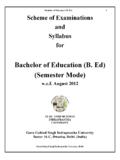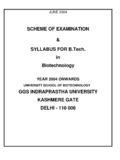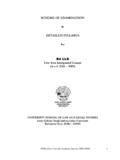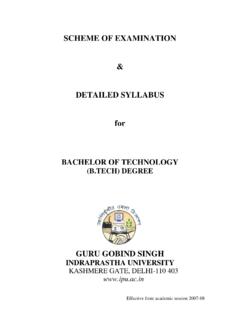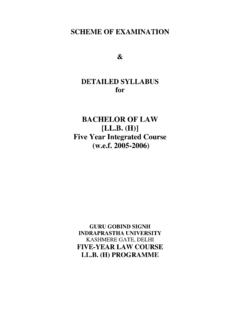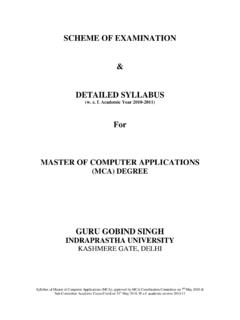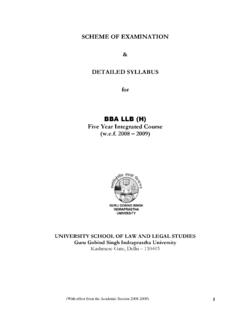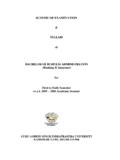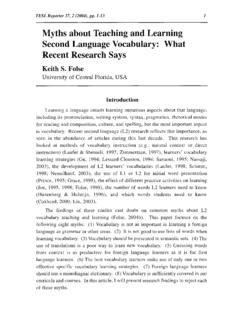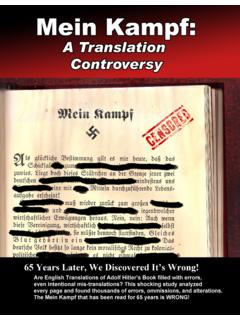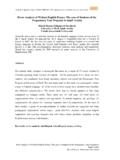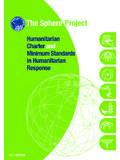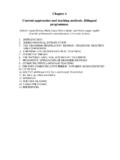Transcription of SCHEME OF EXAMINATION SYLLABI Of BACHELOR …
1 SCHEME OF EXAMINATION & SYLLABI Of BACHELOR OF journalism ( mass communication ) For First to Sixth Semester ( Academic Session 2009-2010 onwards) GURU GOBIND SINGH INDRAPRASTHA UNIVERSITY KASHMERE GATE, DELHI-110403 Academic Session 2009-10 onwards 1 FIRST SEMESTER EXAMINATION Course Code Paper L T/P Credits BJ(MC) 101 Writing for Media 5 - 5 BJ(MC) 103 Socio-Economic & Political Scenario 5 - 5 BJ(MC) 105 Introduction to communication 4 - 4 BJ(MC) 107 Basics of Design & Graphics 4 - 4 *BJ(MC) 109 Indian Culture 5 - 5 Practical BJ(MC) 151 communication Lab - 4 2 BJ(MC) 153 Design & Graphics Lab - 4 2 BJ(MC) 155 Computer Lab-I - 4 2 Total 18 12 24 *Foreign students will study Course Code BJ(MC) 109- Indian Culture in lieu of Course Code BJ(MC) 101- Writing for Media.
2 SECOND SEMESTER EXAMINATION Course Code Paper L T/P Credits BJ(MC) 102 History of Print & Broadcasting in India 5 - 5 BJ(MC) 104 Print journalism -I 4 - 4 BJ(MC) 106 Media Laws & Ethics 5 - 5 BJ(MC) 108 Still Photography 4 - 4 Practical BJ(MC) 152 Print journalism Lab-I - 4 2 BJ(MC) 154 Photo Lab - 4 2 BJ(MC) 156 Computer Lab-II - 4 2 Total 18 12 24 Soon after the Second Semester End-Term EXAMINATION , students will undergo training in Print Media for four weeks and will submit a comprehensive Summer Training Report (STR) alongwith a Power Point Presentation incorporating the work done during the training. The hard copy of the STR (in duplicate) is to be submitted alongwith a soft copy of Power Point Presentation at least 4 weeks before the commencement of End Term EXAMINATION of the Third semester.
3 Academic Session 2009-10 onwards 2 THIRD SEMESTER EXAMINATION Course Code Paper L T/P Credits BJ(MC) 201 Development & communication 5 - 5 BJ(MC) 203 Print journalism -II 5 - 5 BJ(MC) 205 Radio journalism & Production 4 - 4 BJ(MC) 207 Basics of Camera, Lights & Sound 4 - 4 **BJ(MC) 209 Summer Training Report 0 - 4 Practical BJ(MC) 251 Print journalism Lab-II - 4 2 BJ(MC) 253 Radio journalism & Production Lab - 4 2 BJ(MC) 255 Operation & Handling of Video Equipment Lab - 4 2 Total 18 12 28 ** Summer Training Reports will be evaluated by the Board of Examiners comprising of an Internal Examiner and one External Examiner separately out of 50 marks each.
4 The External Examiner will be appointed by the Vice Chancellor. FOURTH SEMESTER EXAMINATION Course Code Paper L T/P Credits BJ(MC) 202 Television journalism & Production 5 5 BJ(MC) 204 Introduction to Advertising 5 - 5 BJ(MC) 206 Public Relations 4 - 4 BJ(MC) 208 New Media 4 - 4 Practical BJ(MC) 252 Television journalism & Production Lab - 4 2 BJ(MC) 254 Public Relations Lab - 4 2 BJ(MC) 256 New Media Lab - 4 2 Total 18 12 24 Soon after the Fourth Semester End Term EXAMINATION , each student will undergo a Functional Exposure Training for six weeks in Electronic Media/Advertising /Public Relations and will submit a Functional Exposure Report [FER] alongwith the Power Point Presentation containing the actual experiential learning.
5 The hard copy of the FER (in duplicate) is to be submitted alongwith a soft copy of the Power Point Presentation, at least 4 weeks before the commencement of End Term EXAMINATION of the Fifth semester. Academic Session 2009-10 onwards 3 FIFTH SEMESTER EXAMINATION Course Code Paper L T/P Credits BJ(MC) 301 Advertising Practices 5 - 5 BJ(MC) 303 Event Management: Principles & Methods 4 - 4 BJ(MC) 305 Media Research 5 - 5 BJ(MC) 307 Environment communication 3 - 3 **BJ(MC) 309 Functional Exposure Report 0 - 4 Practical BJ(MC) 351 Advertising Lab - 4 2 BJ(MC) 353 Event Management Lab - 4 2 BJ(MC) 355 Media Research Lab - 4 2 Total 17 12 27 ** The Functional Exposure Report [FER] carries 100 marks.
6 The report will be evaluated out of 50 marks each by a Board of Examiners comprising of Director/Principal or his/her nominee and one External Examiner to be appointed by the Vice-Chancellor. Every student will be assigned the Final Project at the end of the Fifth Semester. The Final Project will be pursued by him/her under the supervision of an internal supervisor in the Sixth semester. The student will make his/her final project on the subject/theme approved by the Director of the Institute/HOD in the fifth semester. The Project Reports (induplicate) both hard & soft copy will be submitted by the students at least four weeks prior to the date of commencement of the End-Term EXAMINATION of the Sixth Semester. At the time of viva, the students will make a Power Point Presentation of the Final Project. SIXTH SEMESTER EXAMINATION Course Code Paper L T/P Credits BJ(MC) 302 Media Organisation & Management 4 - 4 BJ(MC) 304 Contemporary Issues 5 - 5 BJ(MC) 306 Global Media Scenario 4 - 4 Practical ** BJ(MC) 352 Final Project - - 12 BJ(MC) 354 Comprehensive Viva - - 4 Total 13 - 29 **The Final Project Report carries 100 Marks.
7 It will be evaluated by External and Internal Examiners separately from out of 50 marks each. The External Examiner will be appointed by the Vice Chancellor. Note : Total number of the credits for the BJ(MC) programme = 156 Each student is required to appear in examinations of all courses. However, for the award of degree a student must secure at least 150 credits. Academic Session 2009-10 onwards 4 FIRST SEMESTER WRITING FOR MEDIA Course Code : BJ(MC) 101 L: 5 T/P : 0 CREDITS : 5 Objectives of the Course: On completion of the course students should be able to: 1. Equip themselves with the nuances of writing. 2. Develop both linguistics and communication abilities. 3. Write correctly using proper grammar, vocabulary, syntax, spellings and punctuation. 4. Differentiate between Writing for Print Media and Writing for the Ear. 5. List salient features of Writing for Print Media and Electronic Media and Ad Copies with emphasis on their styles.
8 Marks for Internal Assessment: 25 Unit -I [Essentials of Good Writing] L-18 1. Is writing an art or a craft? i. Can I write? 2. Kinds of Media Writing: i. Writing to Inform ii. Writing to Describe iii. Writing to Persuade 3. The ABCD of Media Writing i. Accuracy ii. Brevity iii. Clarity iv. Discernment 4. Writing Simply 5. Vocabulary i. Vocabulary Building: Using Dictionaries and Thesauri ii. Understanding the Misunderstood Word iii. Rules of Spelling 6. Overcoming Grammar Problems 7. Punctuation Unit II [The Art of Putting Words Together] L- 12 1. The Sentence i. Concision/Clarity 2. Emphasis i. Total Emphasis (That applies to the Whole Sentence) ii. Partial Emphasis (That Applies to a word or Group of Words) 3. Rhythm - Words and How they Sound 4. Variety i. Variety & Recurrence 5. Changing Sentence Length & Pattern 6. Breaking Monotony 7. Varied Openings. Academic Session 2009-10 onwards 5 Course Code : BJ(MC) 101 Unit - III [Putting Sentences Together] L- 12 1.
9 The Paragraph 2. Concise Ideas i. Ideas Dissected into Elements 3. Elements as Paragraphs & Sub Paragraphs i. Putting Paragraphs Together - Logical Sequencing 4. The Complete Picture - The First Draft 5. Reading Aloud For Further Changes 6. Revise Re-revise-Edit 7. Writing Formats : Journals, Letters, Essays & Reports Unit-IV [Translation in journalism ] L- 18 1. Concept & Definition of Translation. 2. Nature & Norms of Translation. 3. Types of Translation i. Word to Word Translation ii. Literal Translation iii. Summarised Translation iv. Free Translation v. Translation based on appropriate reference vi. Translation according to pronunciation (Translation of words & sentences from the source language as it is) vii. Paraphrased Translation (Using Synonyms) 4. The need and importance of Translation in journalism .
10 5. The process of Translation and How to maintain its originality: i. Source Material Perception (Comprehending the Source Language) ii. Analysing the text or Source Material iii. Transfer of Language(Translation Process) iv. Revision of the Translated Text v. Co-ordination & Comparison of Source Language with Original Text and Thus Final Text in Target Language. 6. Guidelines for Translation: Points to be kept in mind while doing Translation i. Don t Opinionate ii. KISS rule iii. Maintaining Originality iv. Summarise with Clarity v. Adhere to Norms of Translation. 7. Practice of Translation from Hindi to English & Vice Versa. Academic Session 2009-10 onwards 6 Course Code : BJ(MC) 101 Instructions for Paper Setter/Moderator Maximum Marks 75 Time 3 hours Total Questions 5 questions of 15 marks each, out of which Question No. 1 will be compulsory. Compulsory question Short answer questions should be asked 6 short answer type questions of 2 marks each or 5 short answer type questions of 3 marks each.

